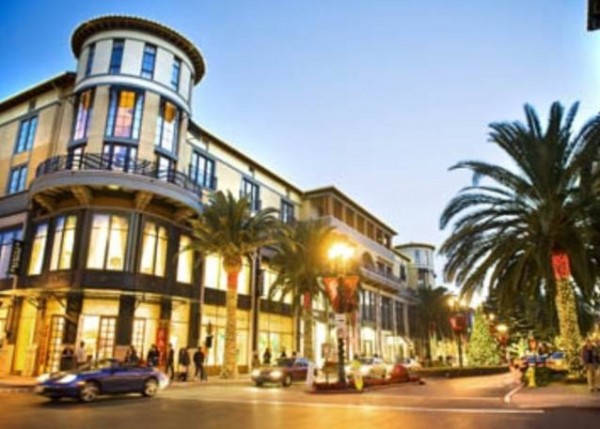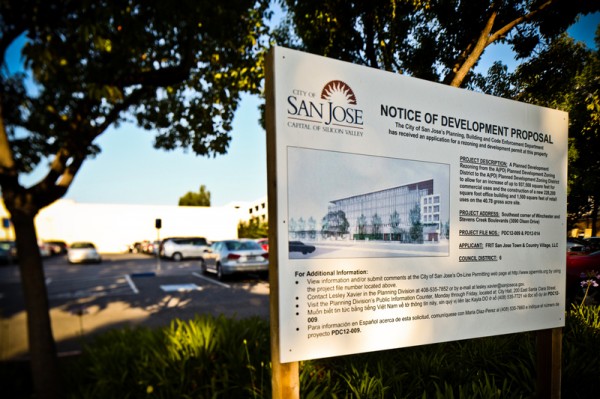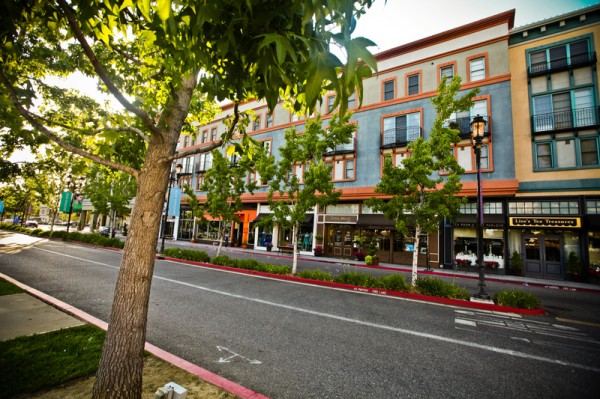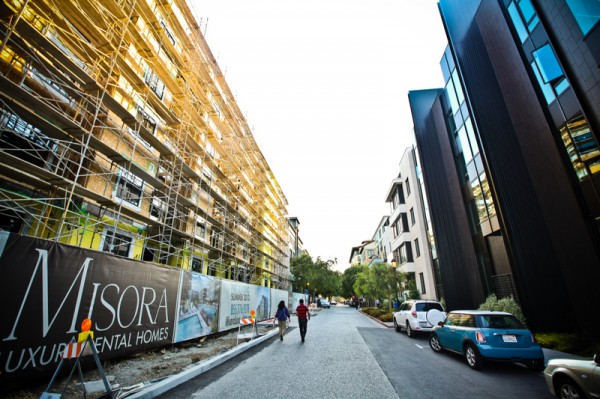
Santana Row
Santana Row
POSTED ON AUGUST 29, 2013 BY PUBLISHER IN COMMERCIAL, FEATURED, HOT LOT
Santana Row and Valley Fair are becoming a South Bay center of gravity.
THIS ARTICLE WAS PUBLISHED IN THE ‘Q’ – THE REGISTRY’S PRINT PUBLICATION – IN AUGUST 2013
By Mary Ann Azevedo
San Jose leaders have been vocal about making their city less of a suburban bedroom community by adding jobs and attracting a younger, hipper population. They are on a mission to create dozens of “urban villages” throughout the city where residents can both work and live. What may surprise those who know San Jose civic history is that the city isn’t pinning all its hopes on downtown.
Under the city’s new general plan, San Jose has designated 70 “urban villages” citywide. One is at Winchester and Stevens Creek boulevards, home to the 42-acre Santana Row redevelopment and Westfield Valley Fair mall, one of the most-selling malls in the country. The vision is to create “active, walkable, bicycle-friendly, transit-oriented, mixed-use urban settings.”
“People who work in office buildings and run those businesses and hire people are learning they need more than a cube, parking space and desk. They need an environment.” Jeff Berkes, Federal Realty Investment Trust
Eleven years ago, when Santana Row opened, many feared the tandem centers would become a retail juggernaut that would kill renewal downtown, a scant three miles east. San Jose has expended some $2 billion in public funds in the last several decades to keep downtown alive.
Meanwhile, more than 1,500 people now live at Santana Row, and the figure is growing. As employers struggle to recruit and keep the best young talent, the neighborhood has become a draw. “Valley Fair and Santana Row have proven to be the shopping hub for Silicon Valley, the South Bay, parts of the East Bay and up the Peninsula,” said Jeff Berkes, West Coast president for Federal Realty Investment Trust, Santana’s developer.
Federal is buying properties adjacent to its 42-acre site for more development, and its aggregate investment is approaching $1 billion. It is pursuing plans to build 690,000 square feet of offices on three sites—including two surface parking lots within its 42-acre footprint and a third it is acquiring that must be re-zoned. Federal already owns an 80,000-square-foot office and retail building at Santana Row, and in total has nearly 105,000 square feet of office space; 85 percent is leased.
“Most companies aren’t going to build their own Googleplex, so we’ve built that for them,” Berkes said. “People who work in office buildings and run those businesses and hire people are learning they need more than a cube, parking space and desk. They need an environment.”
Westfield Corp. Inc. is expanding too with a 1.5 million-square-foot development plan—a parking garage and 640,000 square feet of shop space—originally approved in 2007. Matt Ehrie, district vice president and general manager of Westfield Valley Fair, noted via e-mail that the shopping mall added 12 new retailers over the past year, including Burberry, David Yurman, TAG Heuer and Miu Miu and has 14 more new stores in development. Westfield also is planning a new dining terrace that is slated to begin construction later this year, Ehrie said.
The Winchester family of Winchester Mystery House fame said in April it was bringing an 11.6-acre site on the west side of Santana Row to market for the first time in more than 40 years. The family is offering a redevelopment opportunity under a 50-year ground lease. The land is currently entitled for 500,000 square feet of offices and shops. The Winchester property could accommodate more than a million square feet for the right user, said Silicon Valley’s S. Gregory Davies, a partner with Cassidy Turley Commercial Real Estate Services who is representing the family.
Historically, tech companies wanted to locate in suburban business-park environments with low-rise buildings where they could have a campus. “For 30 years, there was no way to attract a high-tech company to a vertical environment,” Davies said. “It’s almost swapped from product of least choice to product of choice. The entire Stevens Creek corridor is going to take off as a result of the success of the retail centers in that area.”
Photography by Laura Kudritzki
Proximity to Santana Row and Valley Fair is a major selling point at SummerHill Homes’ Midtown Village, where 110 single-family and townhomes priced from the mid $900,000s are being developed, said Robert Freed, president and chief executive of SummerHill. Residents can easily walk to both centers.
Buyers are an ethnically diverse cross-section of mostly high-tech workers in their middle and later 30s with young families. “We have sold out every release within five minutes through an online process,” Freed said.
For now, San Jose officials are paying close attention to Federal’s office leasing. “Depending on how they do, other people will want to get in the game,” said Michael Brilliot, senior planner with the City of San Jose. Developers also are watching the success of the Hotel Valencia at Santana Row, the hotel of choice for visiting pro hockey and football teams. “That’s where the 49ers have apartments and hang out,” he said.
Leah Toeniskoetter, San Jose director for research nonprofit SPUR, believes that Santana Row is proof that South Bay residents like urban environments. “Although it is a development that was created from scratch all at once and is by no means a traditional urban neighborhood, it demonstrates some of the truths about urbanism—that people like to spend time outdoors in public, that good design matters, that people-watching is fun, that it takes a critical mass of pedestrians to give a shopping district energy.”
Still, the jury is out on how strong the economic force for change really is. Todd Oliver, a principal with Terranomics, the retail arm of Cassidy Turley, says land in the area is so expensive that developers have to create density to justify values—moreover, they have to get their hands on the property first: “There’s a lot of viable, strong businesses, and [developers] have to figure out something that makes more money than what’s already there.”
“Leases need to expire and owners would need to sell. That’s a long process; businesses are not wanting to give up that easily,” he said.
Photography by Laura Kudritzki
Source:http://news.theregistrysf.com/santana-row-hipster-alert/




